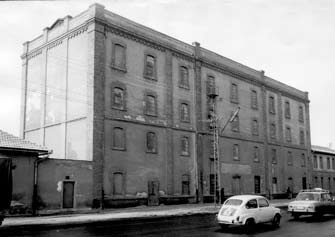The building of a three-way mill on the Belgrade road to no. 120, alongside the City Hospital, is not only a significant element in the development of the city’s economic and industrial structure, but has also played a very sad role in the recent past of the Backa Plain. The first mill project, along the southern city hatch, was created in November 1889 in Budapest, for Ladislav First (Fürszt László). In the absence of archival data we do not know until when First was the owner of the mill. For the first time we meet the names of new owners, with Gabro Smolensky (Szmolenszky Gábor) and Mihail Muic (Muity Mihály) in 1906 when they are looking for permission to build a floor mill. The mill was built that year, and in the coming years it will also receive new auxiliary buildings. The building is known in the city as “Smolenski mill” and this name retains after the change of owner. Mill from Smolensky and Muic in 1909.Henrik Biro (Bíró Henrik) from Budapest is buying the year. Probably between 1909 and 1916, the mill and administrative building next to it, are upgraded from two floors or one floor. During the First World War, more precisely in 1916, Gornjebački Paromin’s shareholding society was formed, within which the “Smolenski Mlin” entered and remained in it until 1941. According to the data of the city engineer Kosta Petrović from 1925, this mill is the largest in the city, employs up to 70 workers and has a capacity of 600 metric cents a day. During the Second World War, it is named the Viking Mill (Viktória). According to the earliest memories of the older Subotica, at the end of the Second World War, fascists of Jewish families were collected in the settlements of Srbobran, Kula, Vrbas, Crvenka, Backa Topola and other places in the settlements of Central Serbia. They concentrated here and kept them for days,without food and water, in extreme inhuman conditions, to be transferred to Bacalmas and continue to death camps in Poland and Germany.
According to the statement, the mill continued to play an insidious role even after the end of the war; The communists also held their prisoners here, and most of them were taken away from there later on to the conspirators. The mill is one of the rare three-story buildings, created in the early 20th century in Subotica, whose facade with few decorative elements, emphasizes a new period in architecture – modern. At the same time, the used material, facade brick and mortar, speak of a strong connection with the already existing city architecture. The second-stage plastic of the building consists of dividing the facade of pilasters from yellow facade bricks into approximately symmetrical fields in relation to the vertical axis of the facade, the final roof crown of the facade brick, and the division of the object vertically into two parts by a simple brick crown at the level of the floor of the second floor.Also from the yellow facade brick are made around the portal and the socket of the building that also ends with a wreath.
SMOLENSKI MILL


0 comments on “SMOLENSKI MILL”